Present and Future of Supercapacitor Technology Applied to Powertrains, Renewable Generation and Grid Connection Applications
Abstract
1. Introduction
- The first and main feature is the capacitance. This parameter represents the energy storage behavior of the SCs, being a function of the voltage and the frequency [12]. This variation, shown in Figure 2a, is between 15% and 20% of the rated capacity [13]. This effect is important in ESS applications since the ESS operating voltage impose a capacitance value different to its rated value, which provokes less stored energy. Moreover, the operation frequency of the SCs modifies the capacitance value. Figure 2b shows that there is a cut-off frequency, usually around 1 Hz depending on the materials and manufacturing processes, where the rated capacitance drastically decreases. Therefore, SCs are usually considered for fast charge–discharge cycles, from tens of seconds to minutes.
- The second effect is the inner resistance. Joule effect takes place in the positive and negative current collectors, the positive and negative porous electrodes and in the separator [12]. Due to the electron transportation process, their kinetic energy is converted into heat. These effects on the conductors and the electrolyte are grouped in a single term named ohmic phenomena and represented by the equivalent series resistance (ESR). The ESR is not constant and depends on the frequency and the cell temperature in a non-linear form [14], as shown in Figure 3. The ESR value is reltively low compared to other electrochemical ESS such as batteries. However, attention should be paid to the ohmic losses on the SCs in those applications which require high power [15]. Moreover, ESR provokes a voltage drop, decreasing the SCs efficiency, and a temperature rise inside the cells. This heat produced from losses needs to be evacuated in order to avoid accelerated aging due to overtemperature. Therefore, proper operation of cooling systems is always required.
- The third parameter in a SC is the self-discharge, which is a drawback of using SCs for cycles longer in the order of hours [16]. The origin of this effect is the redox reactions at the electrode surface when the electrons cross the double layer [17]. This parameter depends mainly on voltage, temperature and aging. Therefore, it could be modelled as a voltage-controlled temperature-dependent current source. The self-discharge current value is given by the manufacturer in the datasheet as a constant value [16].
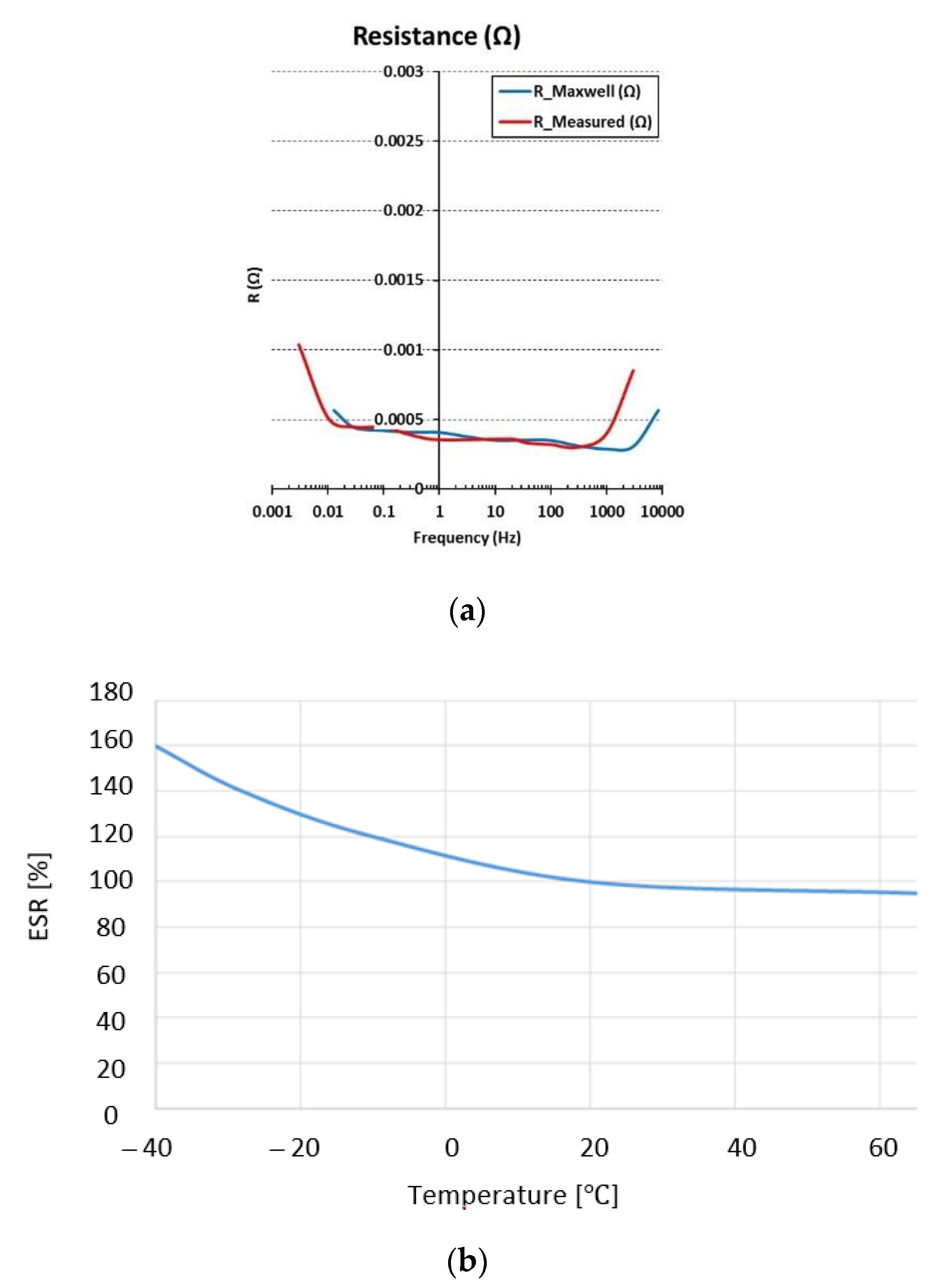
- ESR current value has doubled from its initial value.
- The current capacitance value has decreased by 20% compared to its nominal value.
- The SC operating cycle number is more than 1 million.
- The ohmic losses in the system located in the SCs, represented by the ESR value, the cell-bars which connects the SCs and the power cables.
- The cooling system to maintain the SCs in an optimum operating temperature range.
- The power electronics (conduction and conmutation) losses.
- The most published topic is related to the use of SCs in electric traction applications. This group represents 50% of the published studies. Most of them related to electric vehicles (EV) or hybrid electric vehicles (HEV).
- The second group of the most published topics is related to power grid applications. Most of them are related to the improvement of the control strategy of a microgrid, the voltage and frequency regulation, and the increase of the battery lifespan.
- The third position is for the group of studes related to the renewable generation systems, especially solar PV, wind and wave energy sources. Finally, the last group with 10% of the papers are those applications related to the autonomous power systems, ships and aircrafts.
2. Electric Traction Applications
- Means of public transport power by catenary
- Hybrid electric vehicles
- Pure electric vehicles
- Heavy-rail catenary supplied vehicles
- Heavy-rail diesel–electric vehicles
- Light-rail rapid transit vehicles
- I.
- Acceleration section (beginning of the route): During this acceleration stage, the vehicle goes from zero speed to nominal speed. Moreover, during this phase, the power consumed begins to increase until it reaches its maximum value when the vehicle reaches its nominal speed.
- II.
- Nominal or cruising speed: At this stage, the power drops till a minimum value required to maintain the vehicle speed at its nominal value.
- III.
- Braking or deceleration phase (end of route): During deceleration, the kinetic energy of the vehicle is transformed into electrical energy by means of a regenerative braking.
- Fluctuations in the supply voltage and instability [27].
- Higher losses in the power system.
- Significant energy consumption due to not being able to take advantage of the braking energy: not reversible power supplies and braking chopper.
- Oversized power system due to the need to fully supply the energy consumed by the vehicle.
2.1. Electric Drive for Rail Vehicles
2.1.1. Heavy-Rail Catenary Supplied Vehicles
- The voltage level of the DC stage is adjusted to its optimal value to extract the maximum torque for each speed.
- The use of braking energy in any operational scenario.
- A 10% reduction in system losses is achieved by adjusting the SCs duty cycle in real time.
2.1.2. Heavy-Rail Diesel–Electric Vehicles
2.1.3. Light-Rail Rapid Transit Vehicles
2.2. Electric Drive for Road Vehicles
2.2.1. Public Transportation Catenary-Supplied Vehicles
- SCs and absorbent glass mat (AGM) lead batteries.
- SCs and lithium-ion batteries.
- SCs and lead-acid batteries.
- SCs and lithium-ion iron phosphate batteries.
2.2.2. Hybrid Electric Vehicles (HEVs)
2.2.3. Electric Vehicles (EV)
2.2.4. Wireless Charging of EVs
3. Renewable Generation Applications
3.1. Wind Energy
3.2. Solar PV Energy
3.3. Wave Energy
4. Power Grid Connection Applications
4.1. Grid Regulation: Voltage and Frequency Compensation
- Smoothing the power generated by renewable energy plants in order to mitigate the harmonics of the power injected to the grid.
- HESS control strategy improvement, especially controlling the power and energy flow between the renewable generation sources and the storage systems, with the aim of improving their capabilities against the frequency and voltage fluctuations.
- Introduce the flexibility required by the electric system to improve the voltage and frequency stability.
- Increasing the lifetime of batteries, using the SCs to suppress the high-frequency oscillations and the batteries to smooth the low-frequency power fluctuations.
4.2. Microgrids
- Lifespan improvement of the batteries, using the batteries to smooth the low-frequency power fluctuations in the long-term, while the SCs suppress the high-frequency oscillations.
- Capacity and dimensioning optimization of the HESS required to fulfill with the Microgrid restrictions.
- Consumption reduction by diesel groups or fuel cells.
- Control strategy improvement of the microgrid, especially in controlling the power and energy flow between the renewable generation sources and storage systems, with the aim of improving their behavior in transients and faults.
- Voltage and frequency regulation.
5. Conclusions
- SCs can act as a buffer against large magnitudes and rapid fluctuations in power and for recycling the regenerative braking energy in electric traction vehicles.
- In order to ensure the suitability of SCs in certain applications, it is necessary to define the operating modes of the system, considering the load conditions and taking into account in the control strategy the SoC of ESS. It is also a very important a good dimensioning methodology of energy storage system taking into account the proposed EMS.
- In some cases, HESS can be the best option, but it is necessary to define a control strategy (optimization algorithm) to split the required power between both ESS. This optimization has to take into consideration the cost analysis, the aging of ESS, and weight and volume in the case of on-board systems.
- Remuneration policies for energy returned to the grid and grid code compliance will play a key role in integrating ESS into industrial applications.
Author Contributions
Funding
Institutional Review Board Statement
Informed Consent Statement
Data Availability Statement
Conflicts of Interest
References
- Faraji, S.; Ani, F.N. The development supercapacitor from activated carbon by electroless plating—A review. Renew. Sustain. Energy Rev. 2015, 42, 823–834. [Google Scholar] [CrossRef]
- EASE. European Energy Storage Technology Development Roadmap—2017; EERA: Brussels, Belgium, 2017. [Google Scholar]
- International Electrotechnical Commission. Electrical Energy Storage—White Paper; International Electrotechnical Commission: Geneva, Switzerland, 2011; pp. 1–78. [Google Scholar]
- Beaudin, M.; Zareipour, H.; Schellenberg, A.; Rosehart, W. Energy Storage for Mitigating the Variability of Renewable Electricity Sources. Energy Storage Smart Grids Plan. Oper. Renew. Var. Energy Resour. 2014, 14, 1–33. [Google Scholar]
- FutureBridge Green Ammonia for Energy Storage—FutureBridge. Available online: https://www.futurebridge.com/industry/perspectives-energy/green-ammonia-for-energy-storage/ (accessed on 2 May 2021).
- Zhang, L.; Hu, X.; Wang, Z.; Sun, F.; Dorrell, D.G. A review of supercapacitor modeling, estimation, and applications: A control/management perspective. Renew. Sustain. Energy Rev. 2018, 81, 1868–1878. [Google Scholar] [CrossRef]
- Navarro, G.; Nájera, J.; Torres, J.; Blanco, M.; Santos, M.; Lafoz, M. Development and experimental validation of a supercapacitor frequency domain model for industrial energy applications considering dynamic behaviour at high frequencies. Energies 2020, 13, 1156. [Google Scholar] [CrossRef]
- Buller, S.; Karden, E.; Kok, D.; De Doncker, R.W. Modeling the dynamic behavior of supercapacitors using impedance spectroscopy. IEEE Trans. Ind. Appl. 2002, 38, 1622–1626. [Google Scholar] [CrossRef]
- Rafik, F.; Gualous, H.; Gallay, R.; Crausaz, A.; Berthon, A. Frequency, thermal and voltage supercapacitor characterization and modeling. J. Power Sources 2007, 165, 928–934. [Google Scholar] [CrossRef]
- Lajnef, W.; Vinassa, J.M.; Briat, O.; Azzopardi, S.; Woirgard, E. Characterization methods and modelling of ultracapacitors for use as peak power sources. J. Power Sources 2007, 168, 553–560. [Google Scholar] [CrossRef]
- Zhang, L.; Wang, Z.; Hu, X.; Sun, F.; Dorrell, D.G. A comparative study of equivalent circuit models of ultracapacitors for electric vehicles. J. Power Sources 2015, 274, 899–906. [Google Scholar] [CrossRef]
- Grbovic, P.J. Ultra-Capacitors in Power Conversion Systems: Analysis, Modeling and Design in Theory and Practice; John Wiley and Sons: Chichester, UK, 2014. [Google Scholar]
- Berrueta, A.; San Martín, I.; Hernández, A.; Ursúa, A.; Sanchis, P. Electro-thermal modelling of a supercapacitor and experimental validation. J. Power Sources 2014, 259, 154–165. [Google Scholar] [CrossRef]
- Ghodbane, O.; Ataherian, F.; Wu, N.L.; Favier, F. In situ crystallographic investigations of charge storage mechanisms in MnO 2-based electrochemical capacitors. J. Power Sources 2012, 206, 454–462. [Google Scholar] [CrossRef]
- Torres, J.; Moreno-Torres, P.; Navarro, G.; Blanco, M.; Lafoz, M. Fast energy storage systems comparison in terms of energy efficiency for a specific application. IEEE Access 2018, 6, 40656–40672. [Google Scholar] [CrossRef]
- Maxwell Technologies. Application Note 1007239: Test Procedures for Capacitance, ESR, Leakage Current and Self-Discharge Characterizations of Ultracapacitors; Maxwell Technologies: San Diego, CA, USA, 2015. [Google Scholar]
- Tevi, T.; Takshi, A. Modeling and simulation study of the self-discharge in supercapacitors in presence of a blocking layer. J. Power Sources 2015, 273, 857–862. [Google Scholar] [CrossRef]
- Navarro, G.; Torres, J.; Blanco, M.; González, M.; Lafoz, M. Test Bench Implementation to Calibrate Ageing and Voltage Unbalance in a Large Series Connection of Supercapacitors. In Proceedings of the 2018 20th European Conference on Power Electronics and Applications (EPE’18 ECCE Europe), Riga, Latvia, 17–21 September 2018; IEEE: New York, NY, USA, 2018. [Google Scholar]
- Maxwell Technologies. Ultracapacitors, Supercapacitors, Microelectronics and High Voltage. Available online: https://www.maxwell.com/images/documents/K2Series_DS_1015370_5_20141104.pdf (accessed on 21 October 2017).
- Skeleton Technologies GmbH. Data Sheet Ultracapacitor SCA0500 to SCA3200 Weldable Cells & SCA0300 PCB-Mountable Cell; Skeleton Technologies GmbH: Großröhrsdorf, Germany, 2020. [Google Scholar]
- IOXUS. Data Sheet Ultracapacitor; IOXUS: Oneonta, NY, USA, 2019. [Google Scholar]
- EATON. XL60 Supercapacitors Cylindrical Cells; EATON: Dublin, Ireland, 2017. [Google Scholar]
- KAMCAP Power KAMCAP Supercapacitors. Available online: https://www.kamcappower.com/products/winding-type-2.7-volt-super-capacitors/ (accessed on 27 January 2021).
- LS Mtron Ultracapacitor Products All View POPUP | LS Mtron. Available online: https://www.lsmtron.com/page/popup/productAllView.asp?divisionCode=D0700 (accessed on 27 January 2021).
- VINATECH Supercapacitor |PRODUCTS| VINATECH. Available online: https://www.vinatech.com/spn/product/supercapacitor.php (accessed on 16 May 2021).
- Berrueta, A.; Ursua, A.; Martin, I.S.; Eftekhari, A.; Sanchis, P. Supercapacitors: Electrical Characteristics, Modeling, Applications, and Future Trends. IEEE Access 2019, 7, 50869–50896. [Google Scholar] [CrossRef]
- Rufer, A.; Hotellier, D.; Barrade, P. A supercapacitor-based energy storage substation for voltage compensation in weak transportation networks. IEEE Trans. Power Deliv. 2004, 19, 629–636. [Google Scholar] [CrossRef]
- UIC. High Speed Rail—Fast Track to Sustainable Mobility; International Union of Railways: Paris, France, 2012. [Google Scholar]
- Dutta, O.; Saleh, M.; Khodaparastan, M.; Mohamed, A. A dual-stage modeling and optimization framework for wayside energy storage in electric rail transit systems. Energies 2020, 13, 1614. [Google Scholar] [CrossRef]
- Khodaparastan, M.; Mohamed, A. Flywheel vs. Supercapacitor as wayside energy storage for electric rail transit systems. Inventions 2019, 4, 62. [Google Scholar] [CrossRef]
- Chen, J.; Hu, H.; Ge, Y.; Wang, K.; Huang, W.; He, Z. An energy storage system for recycling regenerative braking energy in high-speed railway. IEEE Trans. Power Deliv. 2021, 36, 320–330. [Google Scholar] [CrossRef]
- Zhong, Z.; Yang, Z.; Fang, X.; Lin, F.; Tian, Z. Hierarchical Optimization of an On-Board Supercapacitor Energy Storage System Considering Train Electric Braking Characteristics and System Loss. IEEE Trans. Veh. Technol. 2020, 69, 2576–2587. [Google Scholar] [CrossRef]
- Xu, C.; Chen, Z.; Cheng, K.W.E.; Wang, X.; Ho, H.F. A supercapacitor-based method to mitigate overvoltage and recycle the energy of pantograph arcing in the high speed railway. Energies 2019, 12, 1214. [Google Scholar] [CrossRef]
- Diesel Locomotives |The Railway Technical Website| PRC Rail Consulting Ltd. Available online: http://www.railway-technical.com/trains/rolling-stock-index-l/diesel-locomotives/ (accessed on 19 April 2021).
- Da Silva Moraes, C.G.; Brockveld Junior, S.L.; Heldwein, M.L.; Franca, A.S.; Vaccari, A.S.; Waltrich, G. Power Conversion Technologies for a Hybrid Energy Storage System in Diesel-Electric Locomotives. IEEE Trans. Ind. Electron. 2020, 1. [Google Scholar] [CrossRef]
- Tram modernisation in Alexandria/Egypt—Urban Transport Magazine. Available online: https://www.urban-transport-magazine.com/en/tram-modernisation-in-alexandria-egypt/ (accessed on 19 April 2021).
- Zhang, X.; Zhang, H.; Li, H.; Jiao, Y.; Liao, H.; Peng, J.; Huang, Z. Cooperative Charging of Supercapacitor Trams with Current Overshoot Suppression. IEEE Trans. Ind. Appl. 2020, 56, 4155–4165. [Google Scholar]
- Ciccarelli, F.; Del Pizzo, A.; Iannuzzi, D. Improvement of energy efficiency in light railway vehicles based on power management control of wayside lithium-ion capacitor storage. IEEE Trans. Power Electron. 2014, 29, 275–286. [Google Scholar] [CrossRef]
- Zhu, F.; Yang, Z.; Xia, H.; Lin, F. Hierarchical Control and Full-Range Dynamic Performance Optimization of the Supercapacitor Energy Storage System in Urban Railway. IEEE Trans. Ind. Electron. 2018, 65, 6646–6656. [Google Scholar] [CrossRef]
- Lafoz, M.; Navarro, G.; Torres, J.; Santiago, Á.; Nájera, J.; Santos-Herran, M.; Blanco, M. Power Supply Solution for Ultrahigh Speed Hyperloop Trains. Smart Cities 2020, 3, 642–656. [Google Scholar] [CrossRef]
- First Solaris Trolleybuses Delivered to Norway In Advance of December Launch. Available online: https://www.focustransport.org/2020/10/ (accessed on 19 April 2021).
- Cignini, F.; Genovese, A.; Ortenzi, F.; Alessandrini, A.; Berzi, L.; Pugi, L.; Barbieri, R. Experimental data comparison of an electric minibus equipped with different energy storage systems. Batteries 2020, 6, 26. [Google Scholar] [CrossRef]
- Soltani, M.; Ronsmans, J.; Kakihara, S.; Jaguemont, J.; Van den Bossche, P.; van Mierlo, J.; Omar, N. Hybrid battery/lithium-ion capacitor energy storage system for a pure electric bus for an urban transportation application. Appl. Sci. 2018, 8, 1176. [Google Scholar] [CrossRef]
- Tran, D.D.; Vafaeipour, M.; El Baghdadi, M.; Barrero, R.; Van Mierlo, J.; Hegazy, O. Thorough state-of-the-art analysis of electric and hybrid vehicle powertrains: Topologies and integrated energy management strategies. Renew. Sustain. Energy Rev. 2020, 119, 109596. [Google Scholar] [CrossRef]
- Passalacqua, M.; Lanzarotto, D.; Repetto, M.; Vaccaro, L.; Bonfiglio, A.; Marchesoni, M. Fuel Economy and EMS for a Series Hybrid Vehicle Based on Supercapacitor Storage. IEEE Trans. Power Electron. 2019, 34, 9966–9977. [Google Scholar] [CrossRef]
- Passalacqua, M.; Carpita, M.; Gavin, S.; Marchesoni, M.; Repetto, M.; Vaccaro, L.; Wasterlain, S. Supercapacitor storage sizing analysis for a series hybrid vehicle. Energies 2019, 12, 1759. [Google Scholar] [CrossRef]
- Blockchain-Based Electric Vehicle Receives $1M from Canadian Government—European Blockchain Convention. Available online: https://eblockchainconvention.com/blockchain-based-electric-vehicle-receives-1m-from-canadian-government/ (accessed on 19 April 2021).
- Hussain, S.; Ali, M.U.; Park, G.-S.; Nengroo, S.H.; Khan, M.A.; Kim, H.-J. A Real-Time Bi-Adaptive Controller-Based Energy Management System for Battery–Supercapacitor Hybrid Electric Vehicles. Energies 2019, 12, 4662. [Google Scholar] [CrossRef]
- Sadeq, T.; Wai, C.K.; Morris, E.; Tarboosh, Q.A.; Aydogdu, O. Optimal Control Strategy to Maximize the Performance of Hybrid Energy Storage System for Electric Vehicle Considering Topography Information. IEEE Access 2020, 8, 216994–217007. [Google Scholar] [CrossRef]
- Shchur, I.; Biletskyi, Y. Interconnection and damping assignment passivity-based control of semi-active and active battery/supercapacitor hybrid energy storage systems for stand-alone photovoltaic installations. In Proceedings of the 14th International Conference on Advanced Trends in Radioelectronics, Telecommunications and Computer Engineering (TCSET), Slavske, Ukraine, 20–24 February 2018; Institute of Electrical and Electronics Engineers Inc.: Piscataway, NJ, USA, 2018; Volume 2018, pp. 324–329. [Google Scholar]
- Yu, H.; Castelli-Dezza, F.; Cheli, F.; Tang, X.; Hu, X.; Lin, X. Dimensioning and Power Management of Hybrid Energy Storage Systems for Electric Vehicles with Multiple Optimization Criteria. IEEE Trans. Power Electron. 2021, 36, 5545–5556. [Google Scholar] [CrossRef]
- Shi, R.; Semsar, S.; Lehn, P.W. Single-Stage Hybrid Energy Storage Integration in Electric Vehicles Using Vector Controlled Power Sharing. IEEE Trans. Ind. Electron. 2020. [Google Scholar] [CrossRef]
- Lu, W.; Zhao, J.; Dong, Y.; Wang, B.; Shen, J. 100 kW electric bus wireless charging system with calculating method for hybrid energy storage capacity. In Proceedings of the 8th International Conference on Power Electronics Systems and Applications: Future Mobility and Future Power Transfer (PESA), Hong Kong, China, 7–10 December 2020; Institute of Electrical and Electronics Engineers Inc.: Piscataway, NJ, USA, 2020. [Google Scholar]
- Geng, Y.; Yang, Z.; Lin, F. Design and Control for Catenary Charged Light Rail Vehicle Based on Wireless Power Transfer and Hybrid Energy Storage System. IEEE Trans. Power Electron. 2020, 35, 7894–7903. [Google Scholar] [CrossRef]
- Azad, A.; Pantic, Z. A Supercapacitor-based Converter Topology for Grid-Side Power Management in Dynamic Wireless Charging Systems. In Proceedings of the ITEC 2019—2019 IEEE Transportation Electrification Conference and Expo; Institute of Electrical and Electronics Engineers Inc.: Piscataway, NJ, USA, 2019. [Google Scholar]
- Ruddell, S.; Madawala, U.K.; Thrimawithana, D.J. A Wireless EV Charging Topology with Integrated Energy Storage. IEEE Trans. Power Electron. 2020, 35, 8965–8972. [Google Scholar] [CrossRef]
- Wu, Y.; Zhang, H.; Liu, M.; Kang, N.; Ma, C. Optimization of super capacitor buffered dynamic wireless power transfer system. In Proceedings of the 2020 IEEE PELS Workshop on Emerging Technologies: Wireless Power Transfer, WoW 2020, Seoul, Korea, 15–19 November 2020; Institute of Electrical and Electronics Engineers Inc.: Piscataway, NJ, USA, 2020; pp. 364–369. [Google Scholar]
- Baggini, A. Handbook of Power Quality. Available online: https://www.wiley.com/en-us/Handbook+of+Power+Quality-p-9780470754238 (accessed on 19 April 2021).
- Ackermann, T. (Ed.) Wind Power in Power Systems; John Wiley and Sons, Ltd.: Chichester, UK, 2012. [Google Scholar]
- Panhwar, I.H.; Ahmed, K.; Seyedmahmoudian, M.; Stojcevski, A.; Horan, B.; Mekhilef, S.; Aslam, A.; Asghar, M. Mitigating Power Fluctuations for Energy Storage in Wind Energy Conversion System Using Supercapacitors. IEEE Access 2020, 8, 189747–189760. [Google Scholar] [CrossRef]
- Liu, J.; Zhang, L. Strategy design of hybrid energy storage system for smoothing wind power fluctuations. Energies 2016, 9, 991. [Google Scholar] [CrossRef]
- Cabrane, Z.; Kim, J.; Yoo, K.; Ouassaid, M. HESS-based photovoltaic/batteries/supercapacitors: Energy management strategy and DC bus voltage stabilization. Sol. Energy 2021, 216, 551–563. [Google Scholar] [CrossRef]
- Palla, N.; Seshadri Sravan Kumar, V. Coordinated Control of PV-Ultracapacitor System for Enhanced Operation under Variable Solar Irradiance and Short-Term Voltage Dips. IEEE Access 2020, 8, 211809–211819. [Google Scholar] [CrossRef]
- Ma, W.; Wang, W.; Wu, X.; Hu, R.; Tang, F.; Zhang, W.; Han, X.; Ding, L. Optimal Allocation of Hybrid Energy Storage Systems for Smoothing Photovoltaic Power Fluctuations Considering the Active Power Curtailment of Photovoltaic. IEEE Access 2019, 7, 74787–74799. [Google Scholar] [CrossRef]
- Lafoz, M.; Blanco, M.; Ramírez, D. Grid connection for wave power farms. In Proceedings of the 14th European Conference on Power Electronics and Applications, Birmingham, UK, 30 August–1 September 2011; IEEE: Birmingham, UK, 2011; pp. 1–10. [Google Scholar]
- Blavette, A.; O’Sullivan, D.L.; Alcorn, R.; Lewis, T.W.; Egan, M.G. Impact of a medium-size wave farm on grids of different strength levels. IEEE Trans. Power Syst. 2014, 29, 917–923. [Google Scholar] [CrossRef]
- Eltigani, D.; Masri, S. Challenges of integrating renewable energy sources to smart grids: A review. Renew. Sustain. Energy Rev. 2015, 52, 770–780. [Google Scholar] [CrossRef]
- MaRINET2. MaRINET2 Wave Facilities. Available online: http://www.marinet2.eu/facilities/wave/ (accessed on 19 April 2021).
- Nunez Forestieri, J.; Farasat, M. Integrative sizing/real-Time energy management of a hybrid supercapacitor/undersea energy storage system for grid integration of wave energy conversion systems. IEEE J. Emerg. Sel. Top. Power Electron. 2020, 8, 3798–3810. [Google Scholar] [CrossRef]
- Rajapakse, G.; Jayasinghe, S.; Fleming, A.; Negnevitsky, M. Grid integration and power smoothing of an oscillatingwater column wave energy converter. Energies 2018, 11, 1871. [Google Scholar] [CrossRef]
- Babu, T.S.; Vasudevan, K.R.; Ramachandaramurthy, V.K.; Sani, S.B.; Chemud, S.; Lajim, R.M. A Comprehensive Review of Hybrid Energy Storage Systems: Converter Topologies, Control Strategies and Future Prospects. IEEE Access 2020, 8, 148702–148721. [Google Scholar] [CrossRef]
- Rocabert, J.; Capo-Misut, R.; Munoz-Aguilar, R.S.; Candela, J.I.; Rodriguez, P. Control of Energy Storage System Integrating Electrochemical Batteries and Supercapacitors for Grid-Connected Applications. IEEE Trans. Ind. Appl. 2019, 55, 1853–1862. [Google Scholar] [CrossRef]
- Manandhar, U.; Ukil, A.; Gooi, H.B.; Tummuru, N.R.; Kollimalla, S.K.; Wang, B.; Chaudhari, K. Energy management and control for grid connected hybrid energy storage system under different operating modes. IEEE Trans. Smart Grid 2019, 10, 1626–1636. [Google Scholar] [CrossRef]
- Akram, U.; Khalid, M. A Coordinated Frequency Regulation Framework Based on Hybrid Battery-Ultracapacitor Energy Storage Technologies. IEEE Access 2017, 6, 7310–7320. [Google Scholar] [CrossRef]
- Nguyen-Huu, T.-A.; Nguyen, V.T.; Hur, K.; Shim, J.W. Coordinated Control of a Hybrid Energy Storage System for Improving the Capability of Frequency Regulation and State-of-Charge Management. Energies 2020, 13, 6304. [Google Scholar] [CrossRef]
- Pham, V.L.; Wada, K. Applications of triple active bridge converter for future grid and integrated energy systems. Energies 2020, 13, 1577. [Google Scholar] [CrossRef]
- Georgious, R.; Garcia, J.; Sumner, M.; Saeed, S.; Garcia, P. Fault Ride-through power electronic topologies for hybrid energy storage systems. Energies 2020, 13, 257. [Google Scholar] [CrossRef]
- Arkhangelski, J.; Roncero-Sánchez, P.; Abdou-Tankari, M.; Vázquez, J.; Lefebvre, G. Control and restrictions of a hybrid renewable energy system connected to the grid: A battery and supercapacitor storage case. Energies 2019, 12, 2776. [Google Scholar] [CrossRef]
- Malkawi, A.M.A.; Lopes, L.A.C. Improved dynamic voltage regulation in a droop controlled DC nanogrid employing independently controlled battery and supercapacitor units. Appl. Sci. 2018, 8, 1525. [Google Scholar] [CrossRef]
- Fang, J.; Tang, Y.; Li, H.; Li, X. A Battery/Ultracapacitor Hybrid Energy Storage System for Implementing the Power Management of Virtual Synchronous Generators. IEEE Trans. Power Electron. 2018, 33, 2820–2824. [Google Scholar] [CrossRef]
- Khalid, M. A review on the selected applications of battery-supercapacitor hybrid energy storage systems for microgrids. Energies 2019, 12, 4559. [Google Scholar] [CrossRef]
- Torkashvand, M.; Khodadadi, A.; Sanjareh, M.B.; Nazary, M.H. A Life Cycle-Cost Analysis of Li-ion and Lead-Acid BESSs and Their Actively Hybridized ESSs with Supercapacitors for Islanded Microgrid Applications. IEEE Access 2020, 8, 153215–153225. [Google Scholar] [CrossRef]
- Zhu, Y.; Fan, Q.; Xiong, L.; Zhang, G.; Qian, X. Coordination control strategy for battery-ultracapacitor hybrid energy storage system in microgrids with unbalanced and nonlinear loads. IEEE Access 2019, 7, 111577–111591. [Google Scholar] [CrossRef]
- Oriti, G.; Anglani, N.; Julian, A.L. Hybrid Energy Storage Control in a Remote Military Microgrid with Improved Supercapacitor Utilization and Sensitivity Analysis. In IEEE Transactions on Industry Applications; Institute of Electrical and Electronics Engineers Inc.: Piscataway, NJ, USA, 2019; Volume 55, pp. 5099–5108. [Google Scholar]
- Oriti, G.; Julian, A.L.; Anglani, N.; Hernandez, G.D. Novel Economic Analysis to Design the Energy Storage Control System of a Remote Islanded Microgrid. IEEE Trans. Ind. Appl. 2018, 54, 6332–6342. [Google Scholar] [CrossRef]
- Akram, U.; Khalid, M.; Shafiq, S. An innovative hybrid wind-solar and battery-supercapacitor microgrid system—development and optimization. IEEE Access 2017, 5, 25897–25912. [Google Scholar] [CrossRef]
- Ghosh, S.K.; Roy, T.K.; Pramanik, M.A.H.; Sarkar, A.K.; Mahmud, M.A. An energy management system-based control strategy for DC microgrids with dual energy storage systems. Energies 2020, 13, 2992. [Google Scholar] [CrossRef]
- Kamel, A.; Rezk, H.; Shehata, N.; Thomas, J. Energy Management of a DC Microgrid Composed of Photovoltaic/Fuel Cell/Battery/Supercapacitor Systems. Batteries 2019, 5, 63. [Google Scholar] [CrossRef]
- Wu, T.; Yu, W.; Wang, L.; Guo, L.; Tang, Z. Power distribution strategy of microgrid hybrid energy storage system based on improved hierarchical control. Energies 2019, 12, 3498. [Google Scholar] [CrossRef]
- Yu, M.; Zhang, J.; Liu, H. Improved control of forest microgrids with hybrid complementary energy storage. Appl. Sci. 2019, 9, 2523. [Google Scholar] [CrossRef]
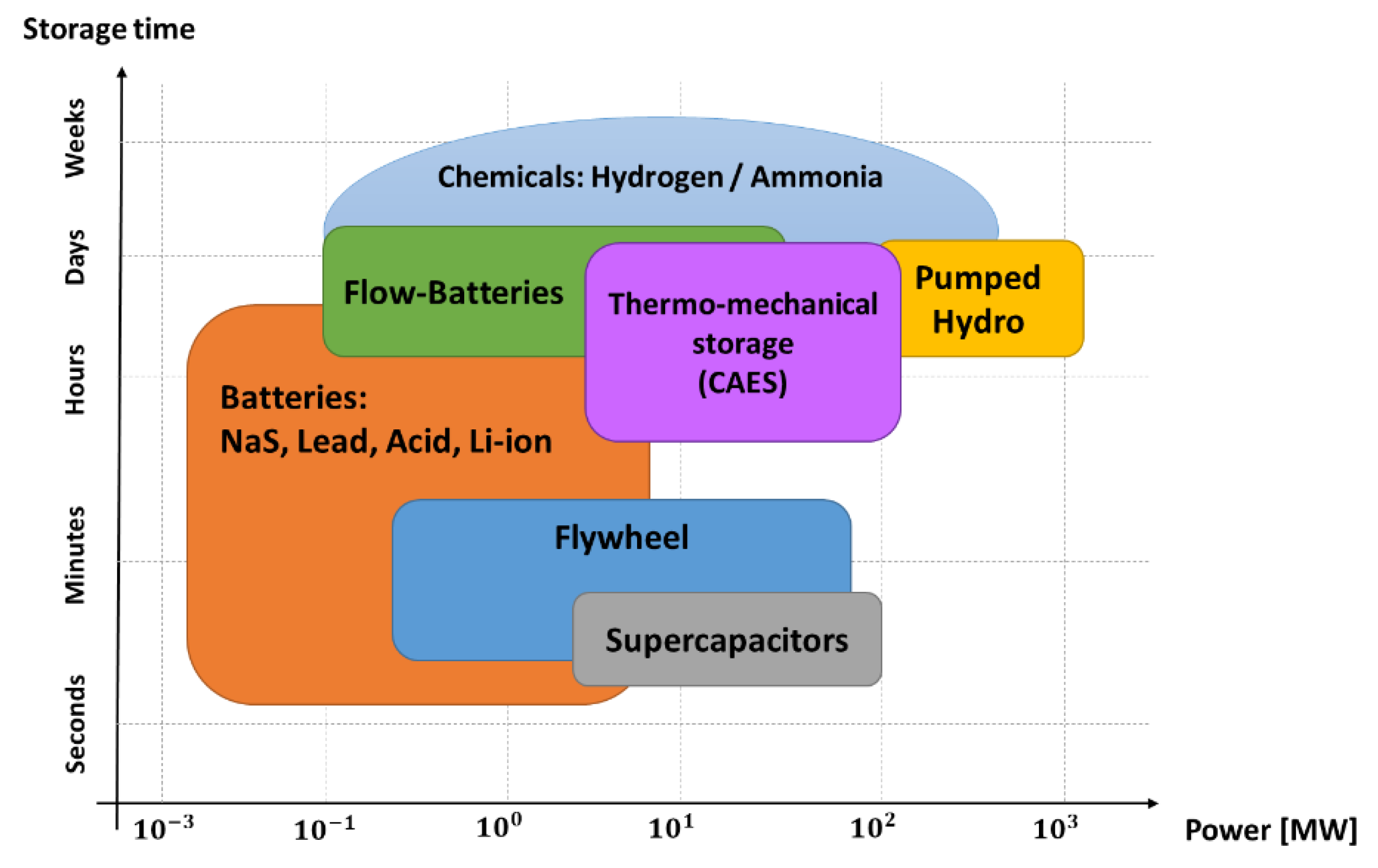
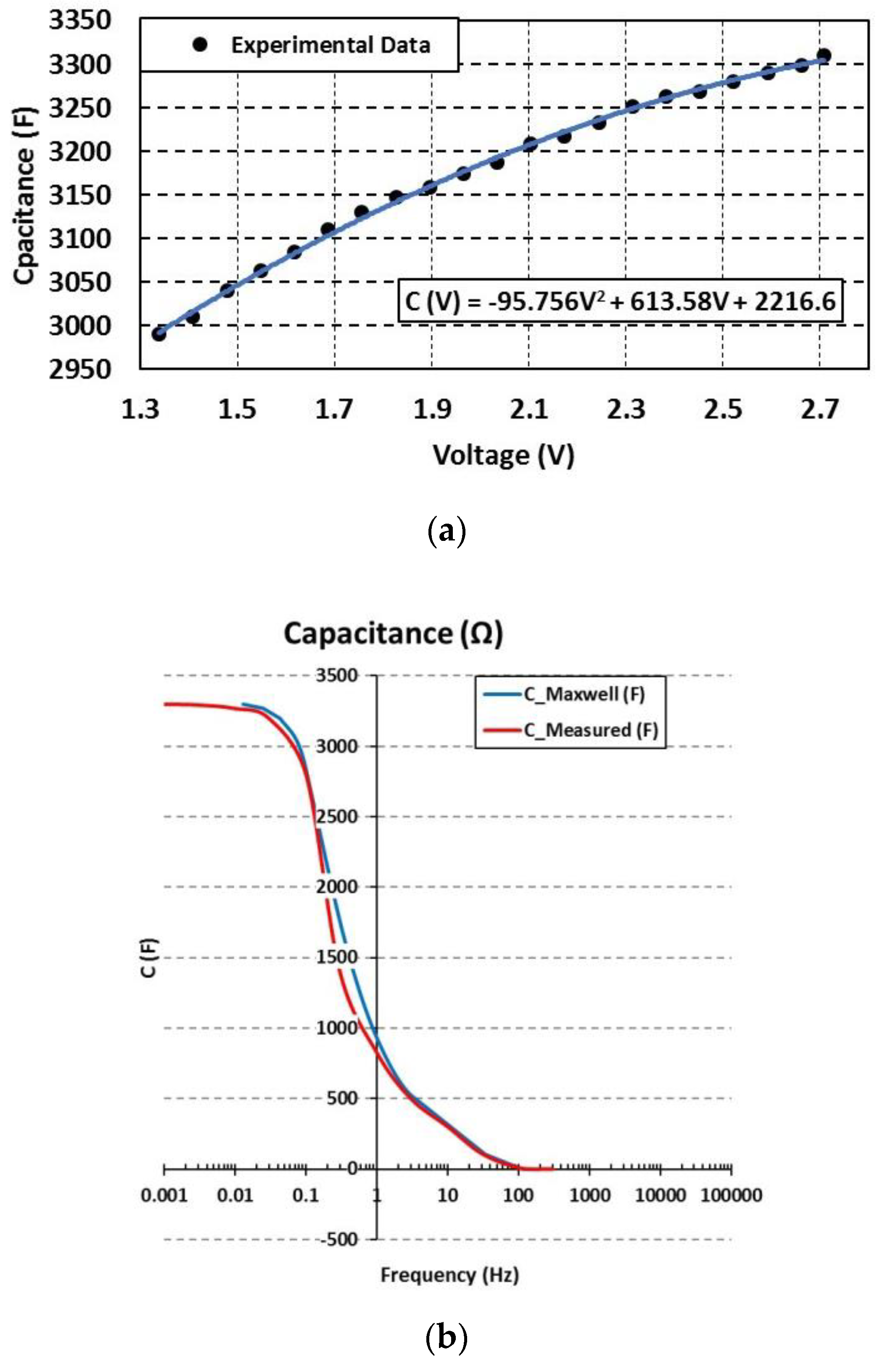

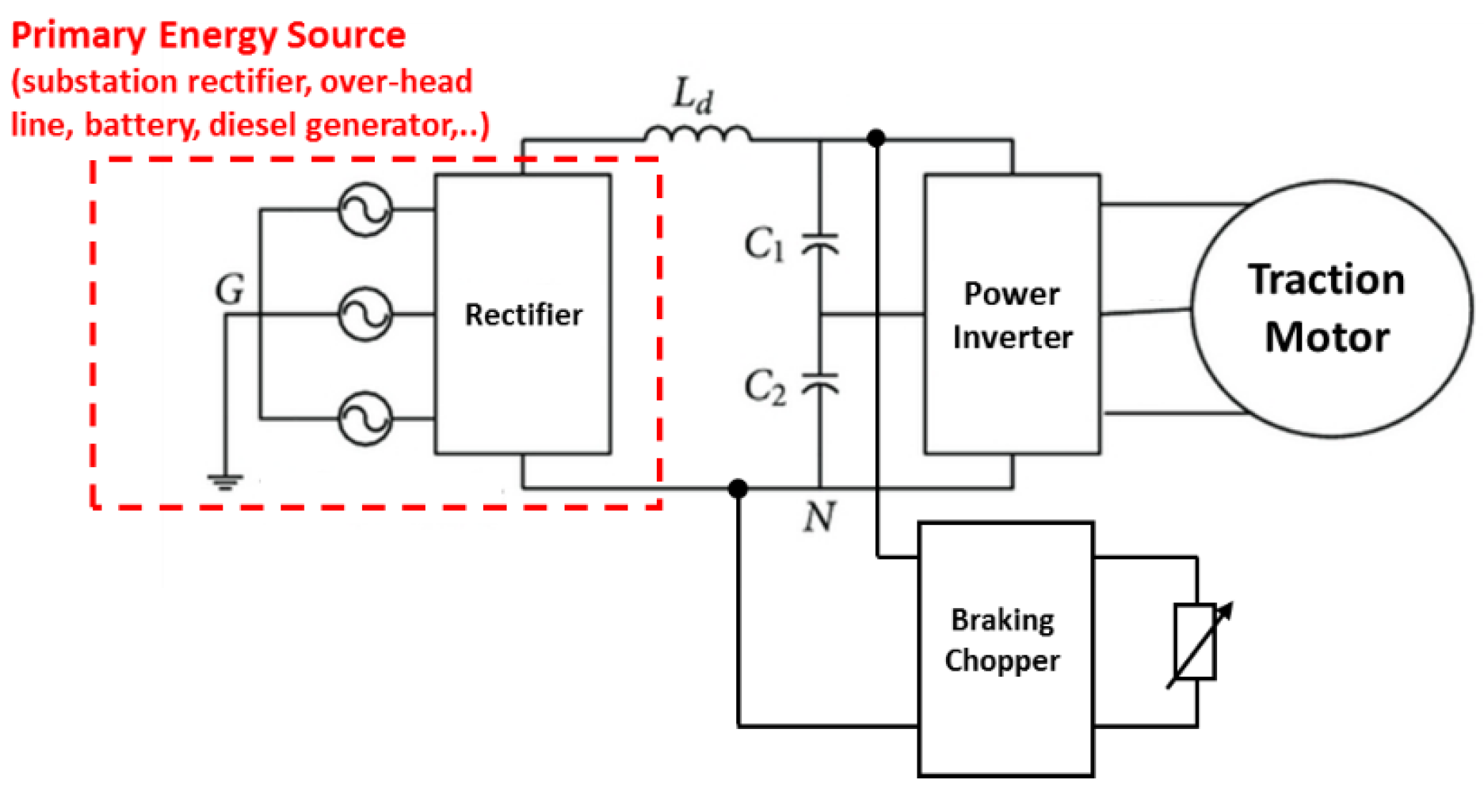
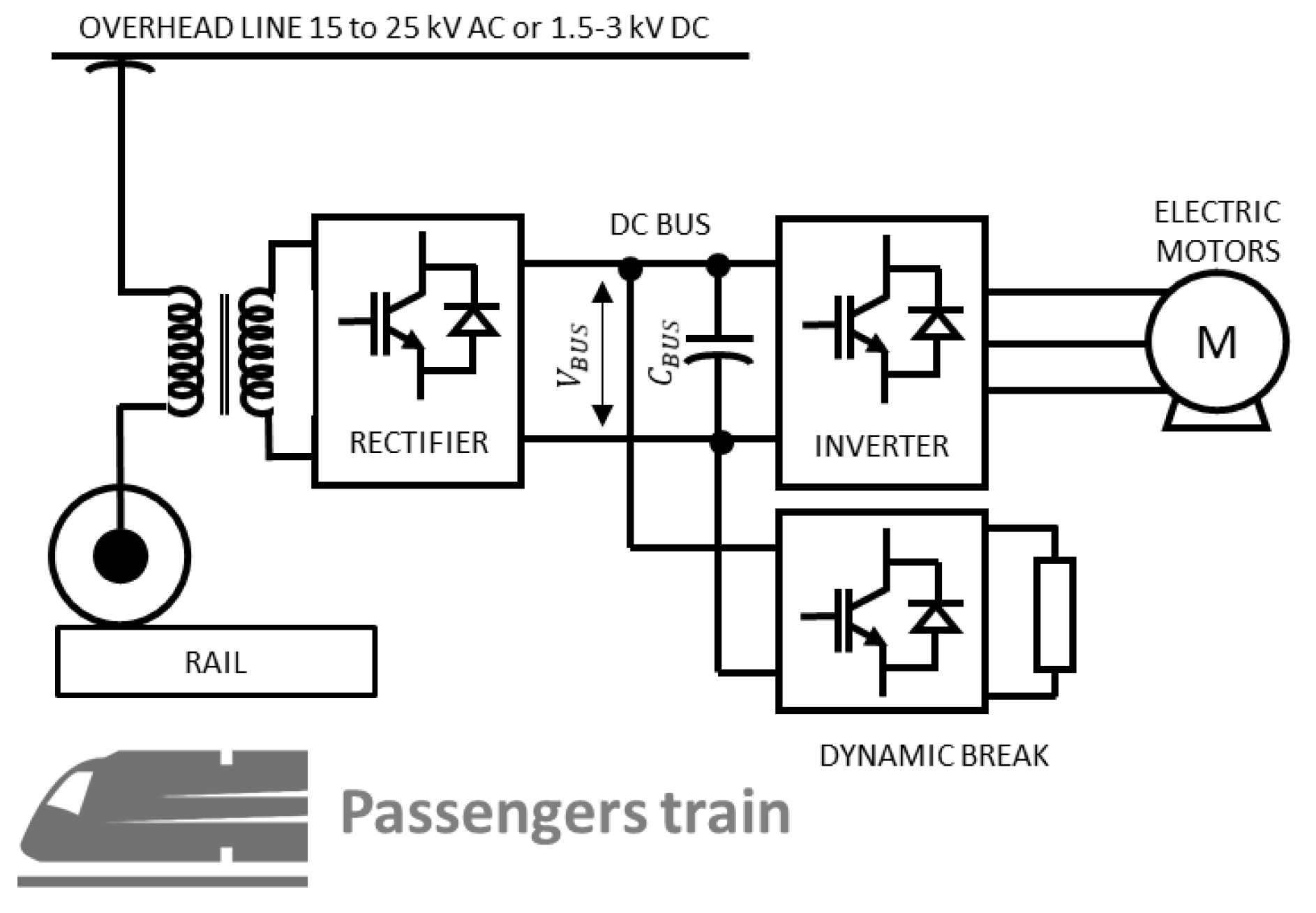
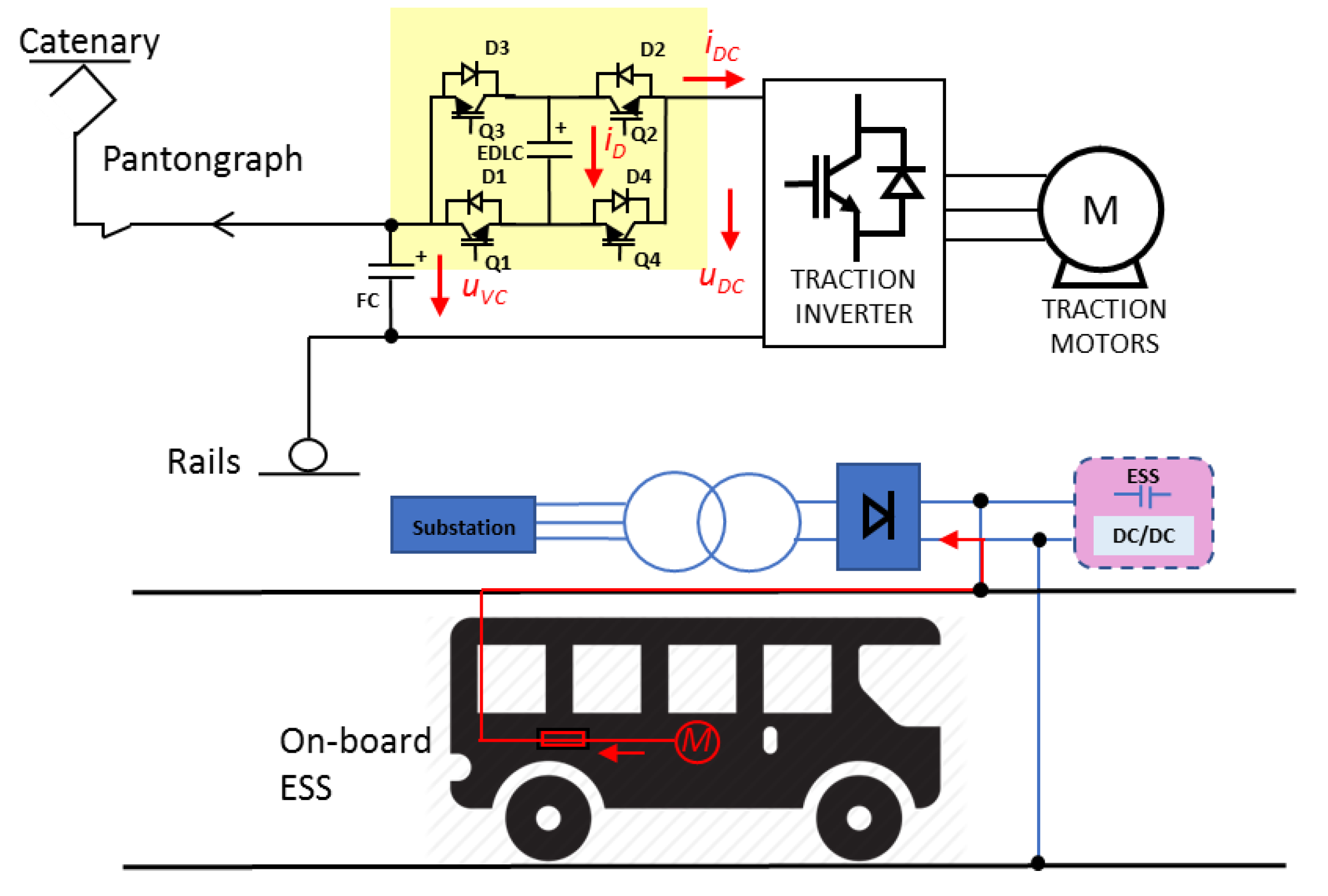
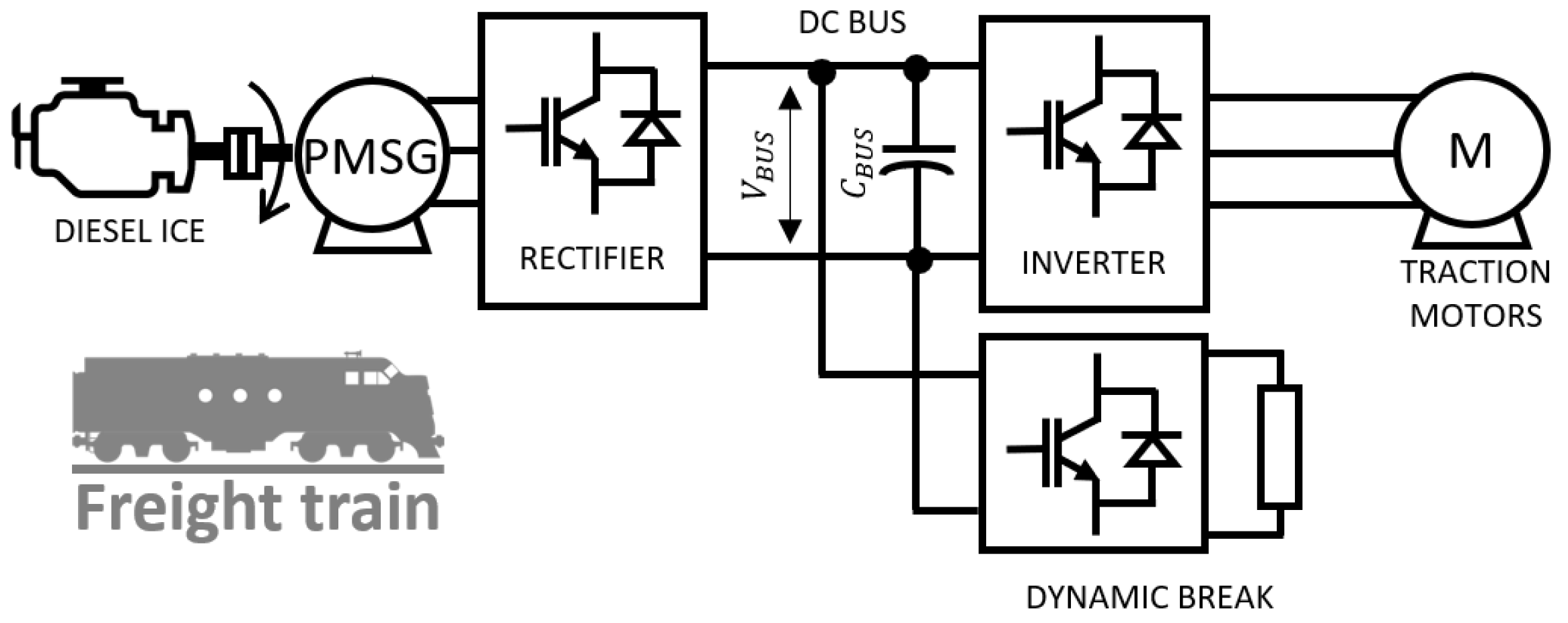

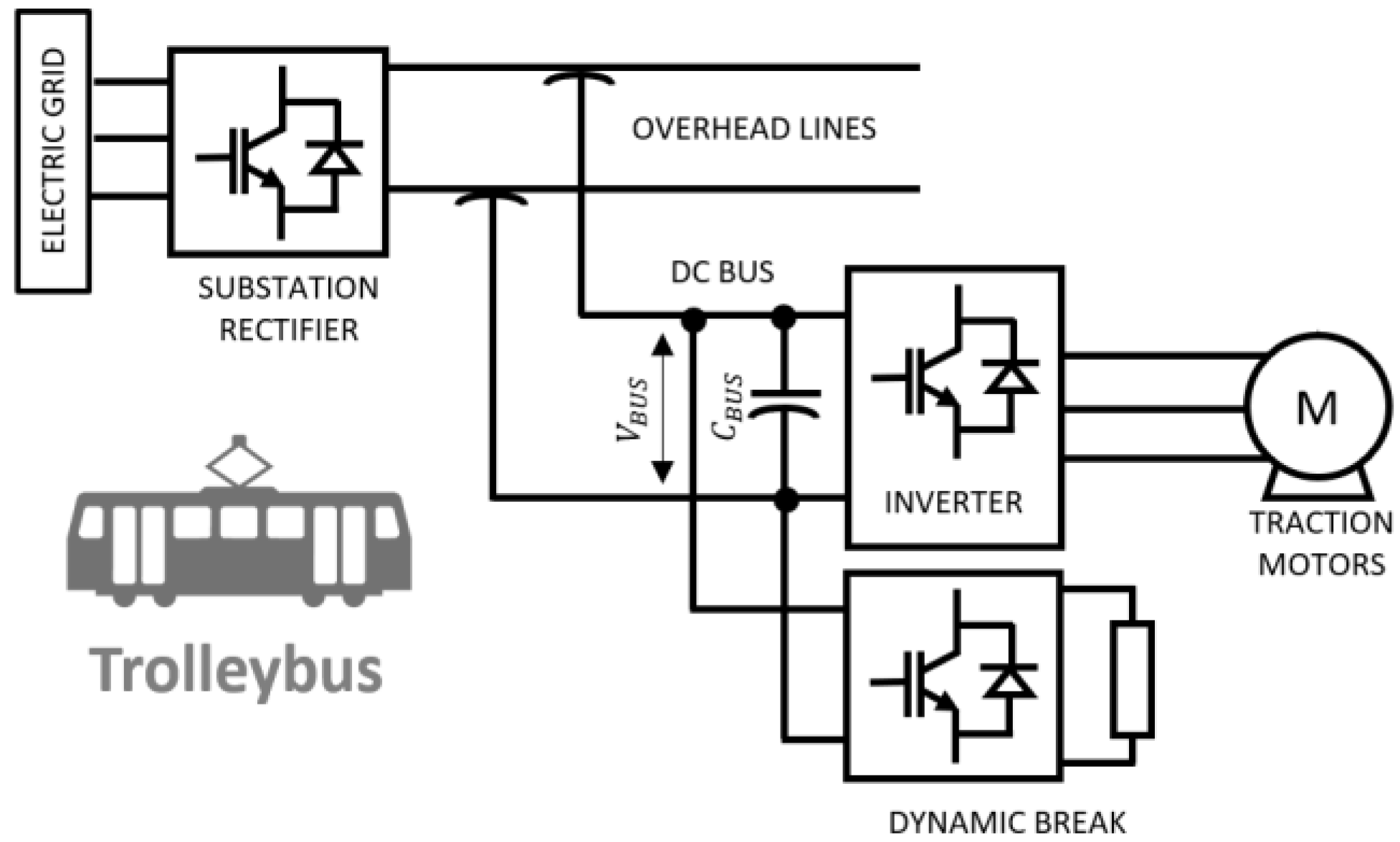
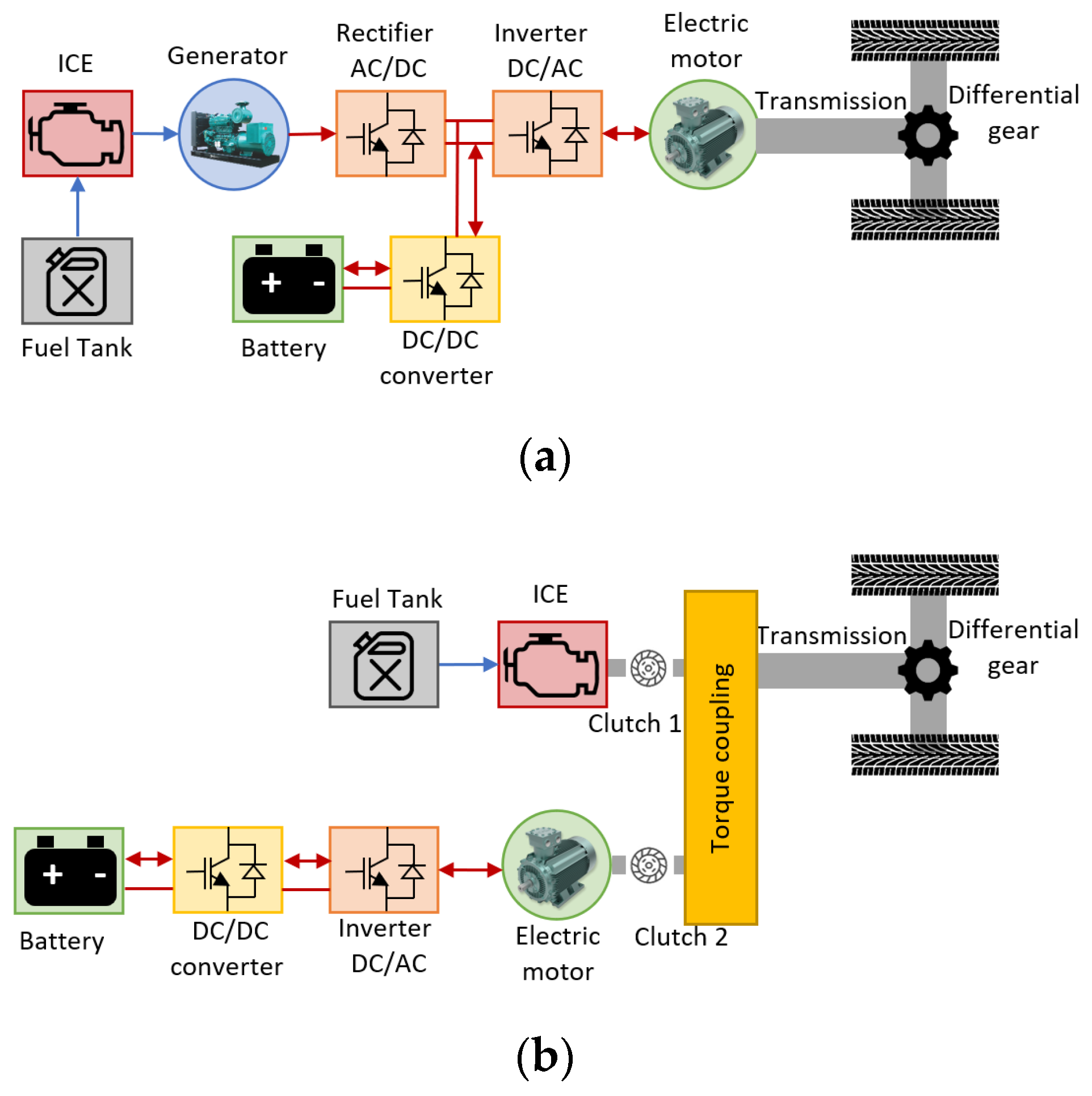
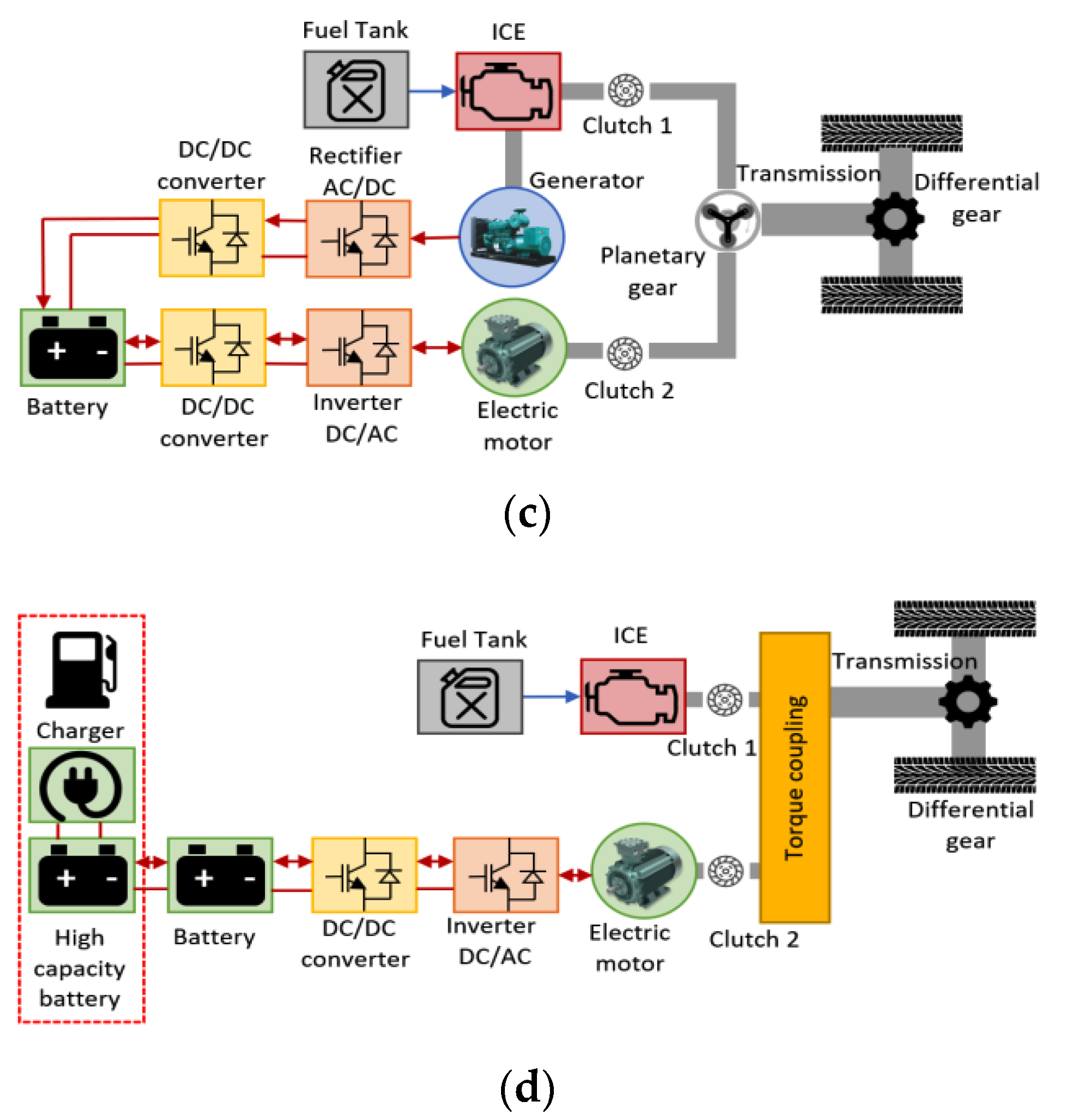
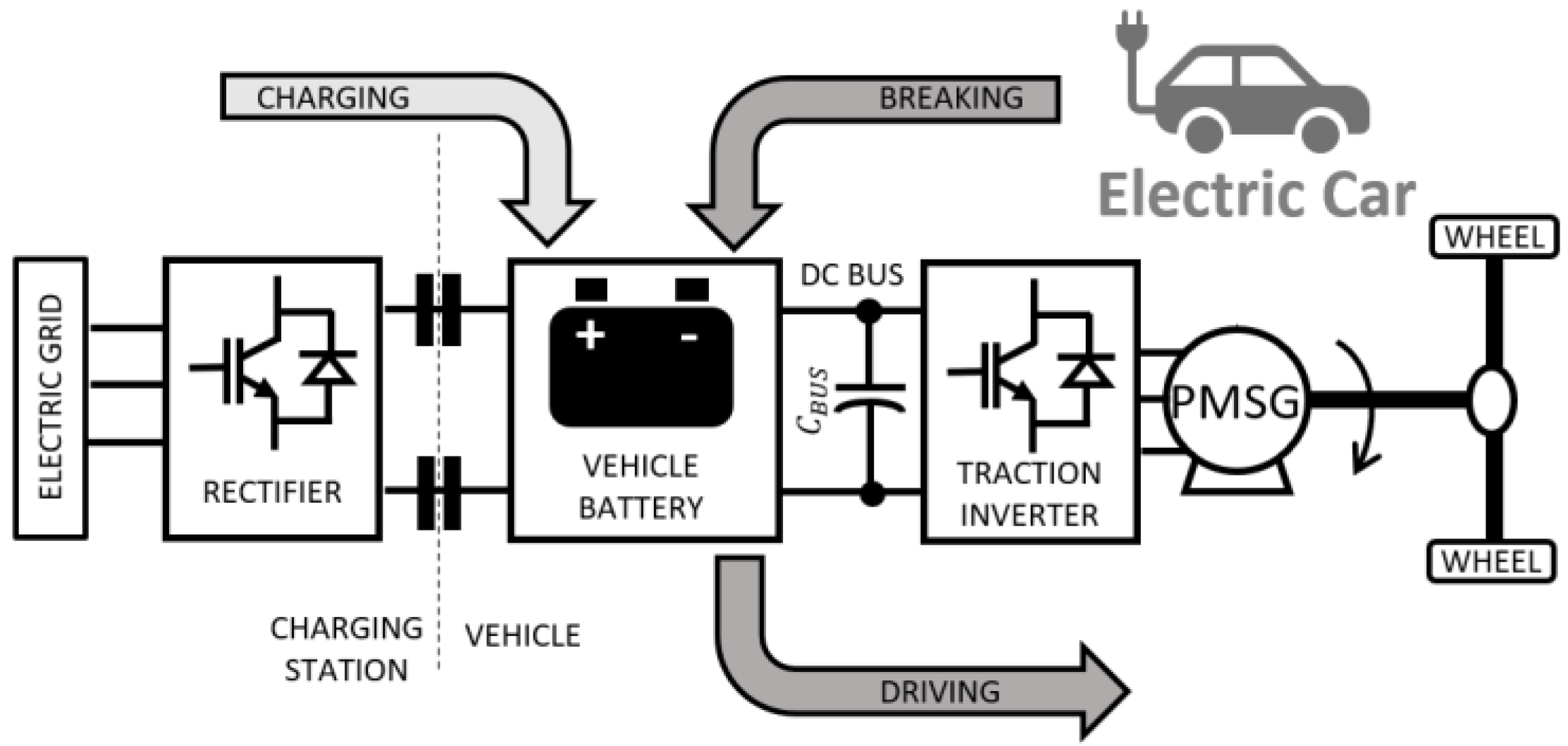
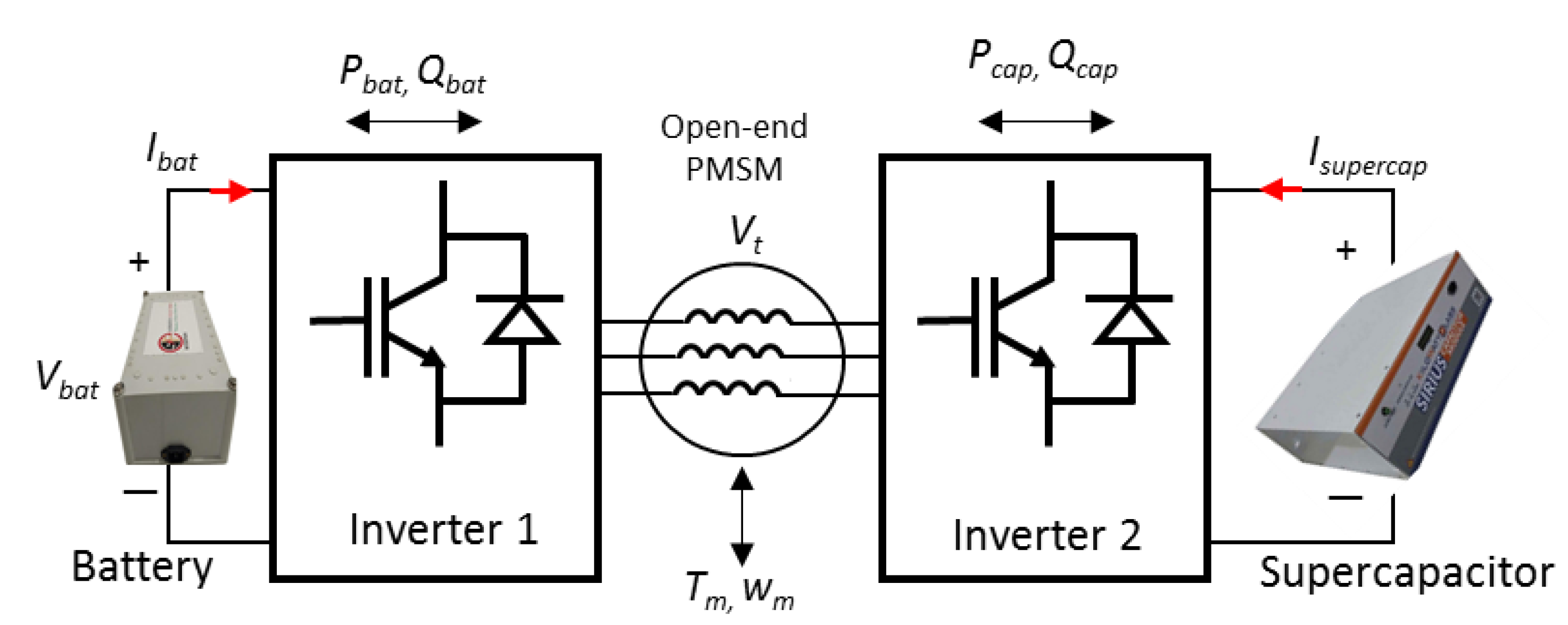
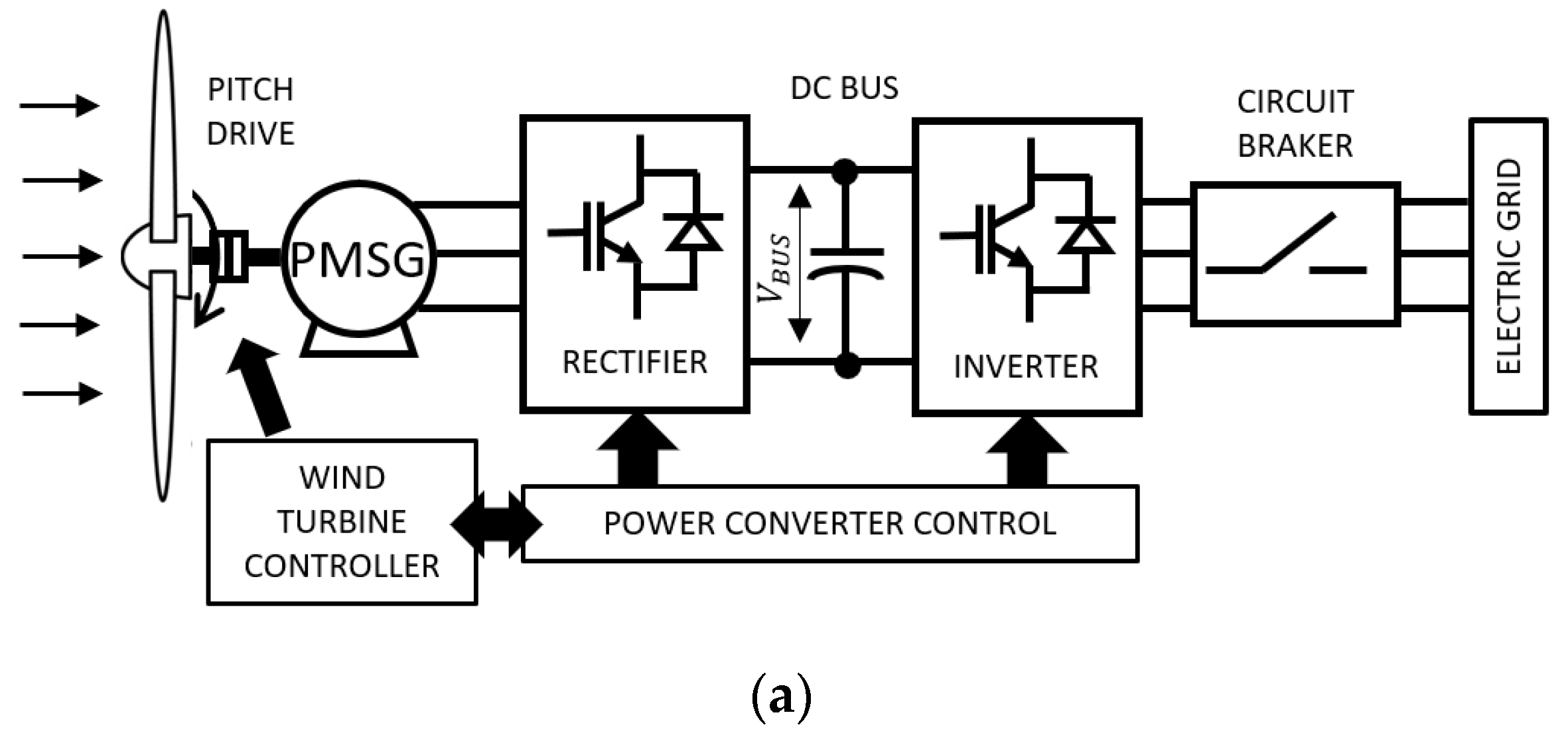
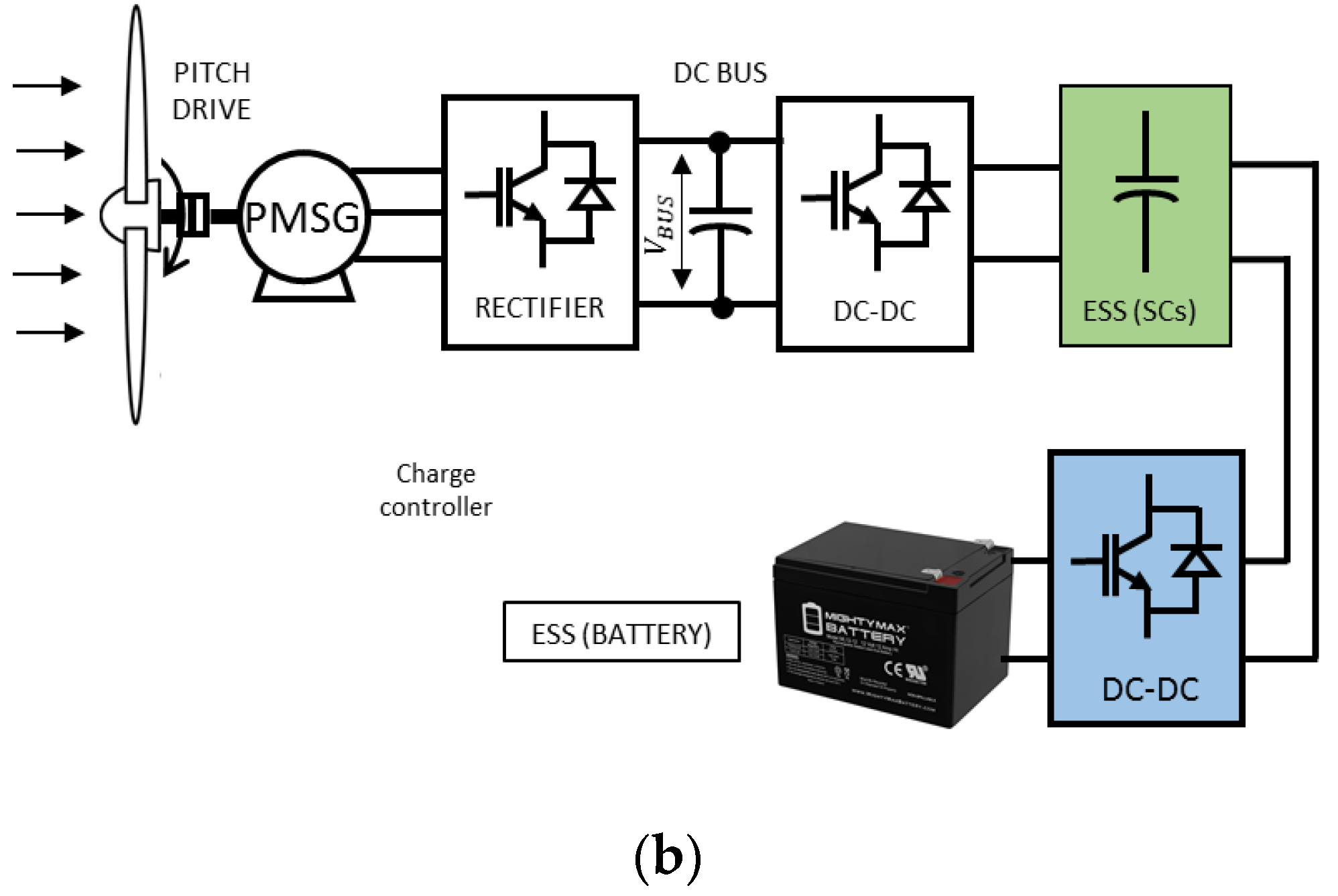
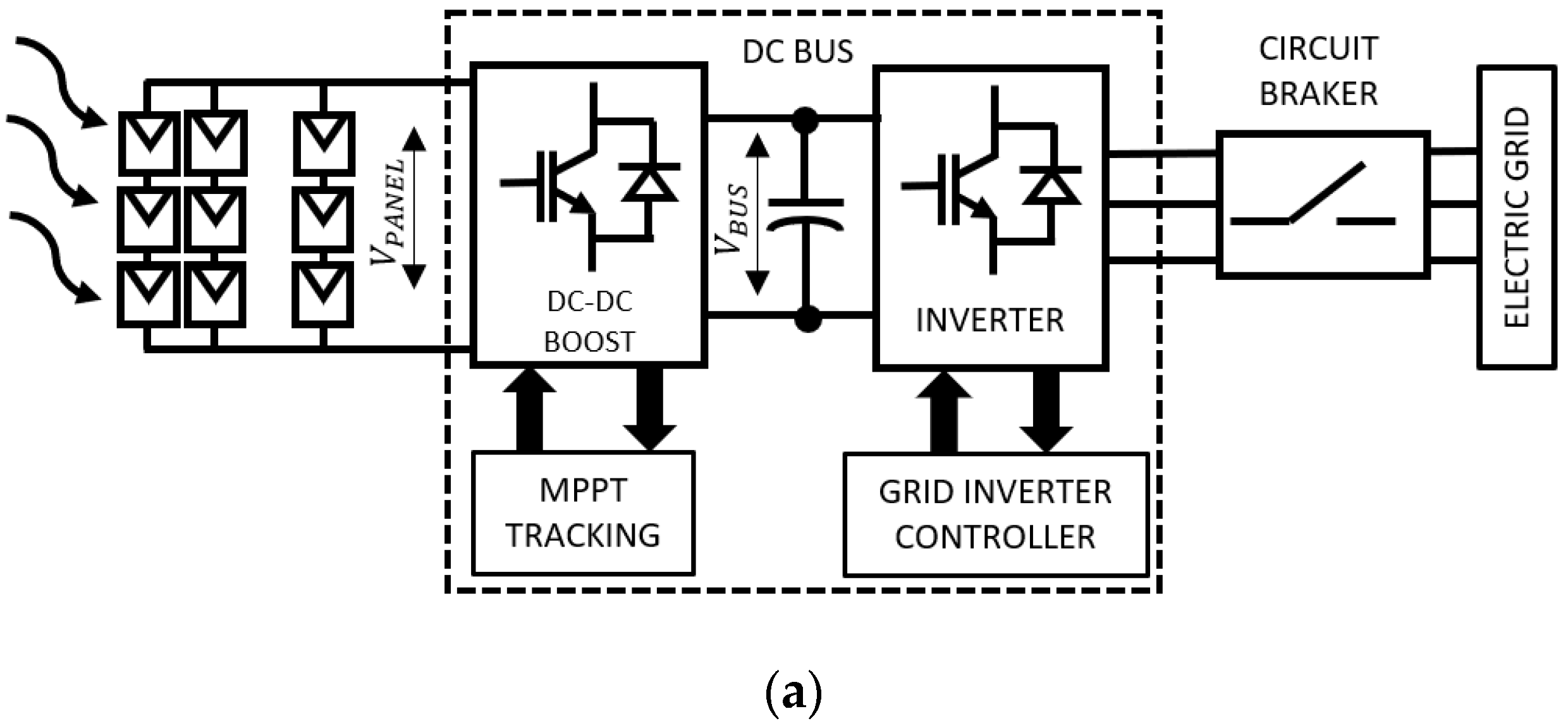
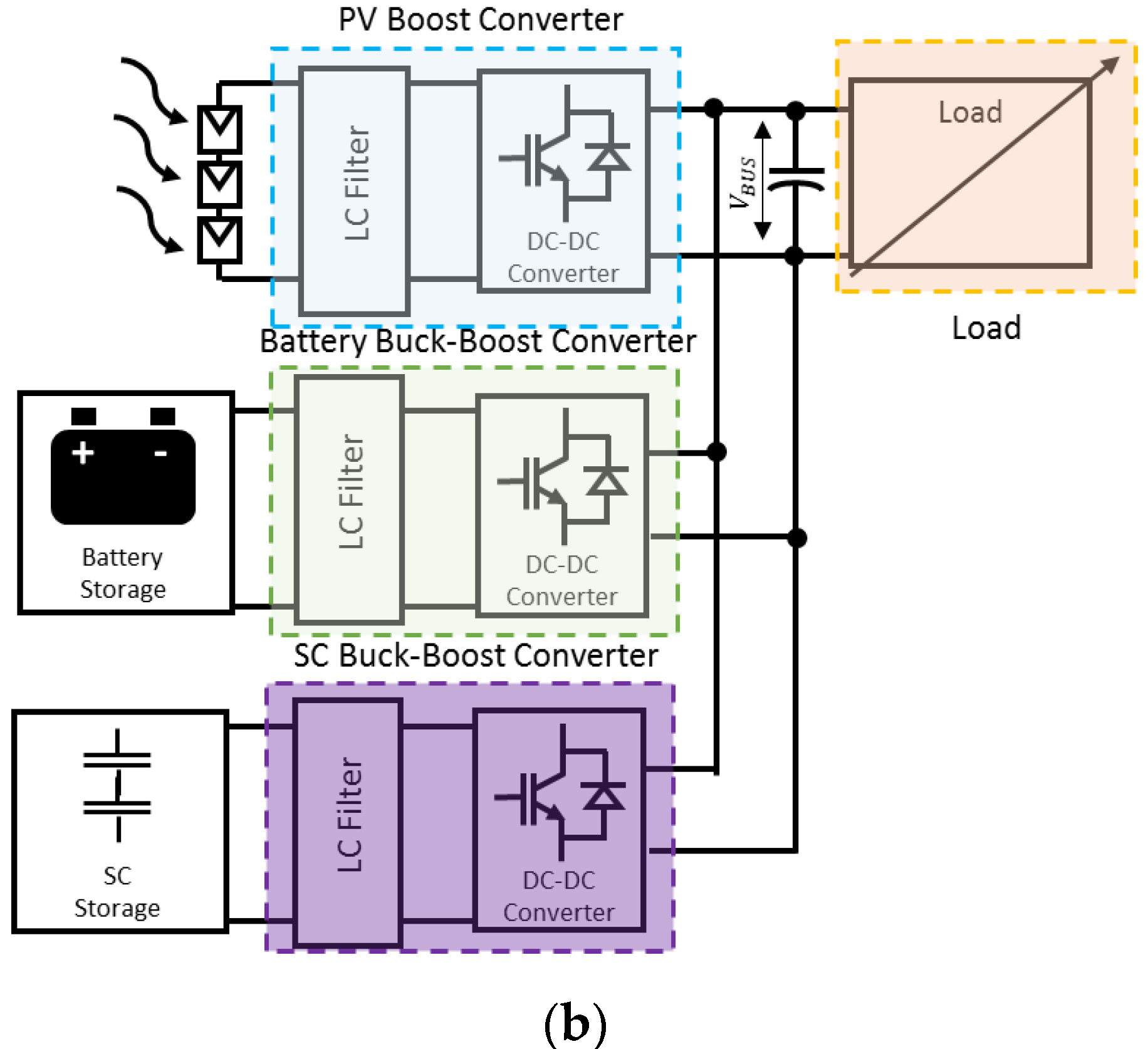
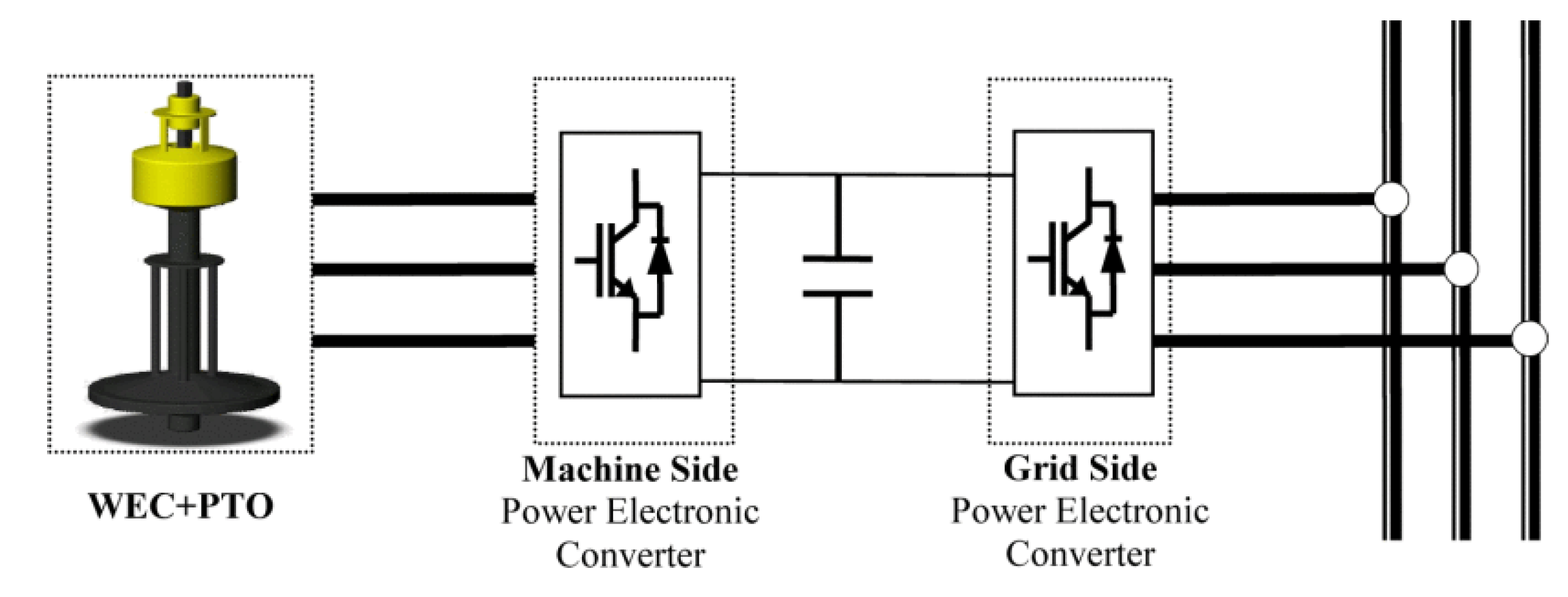

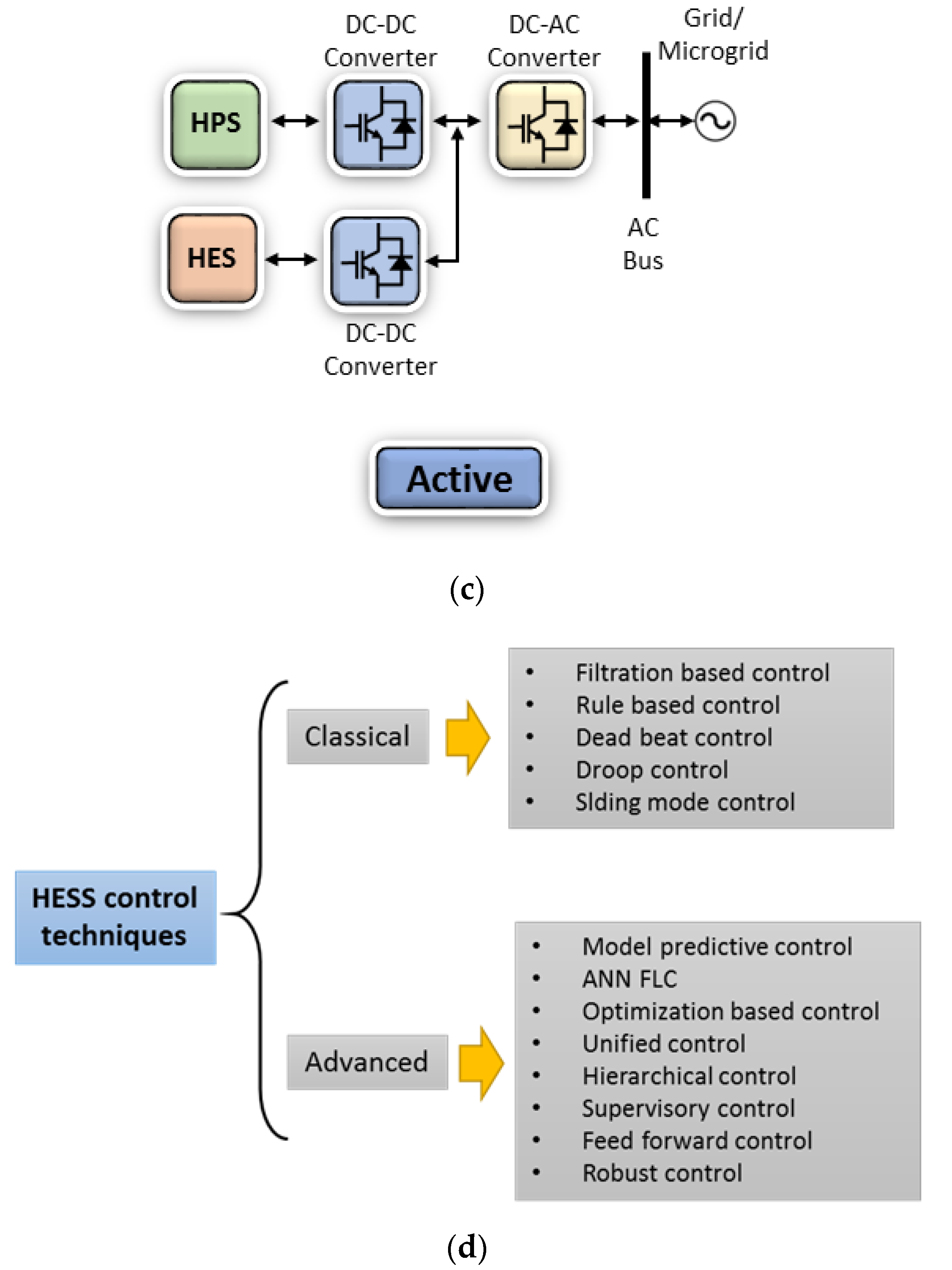
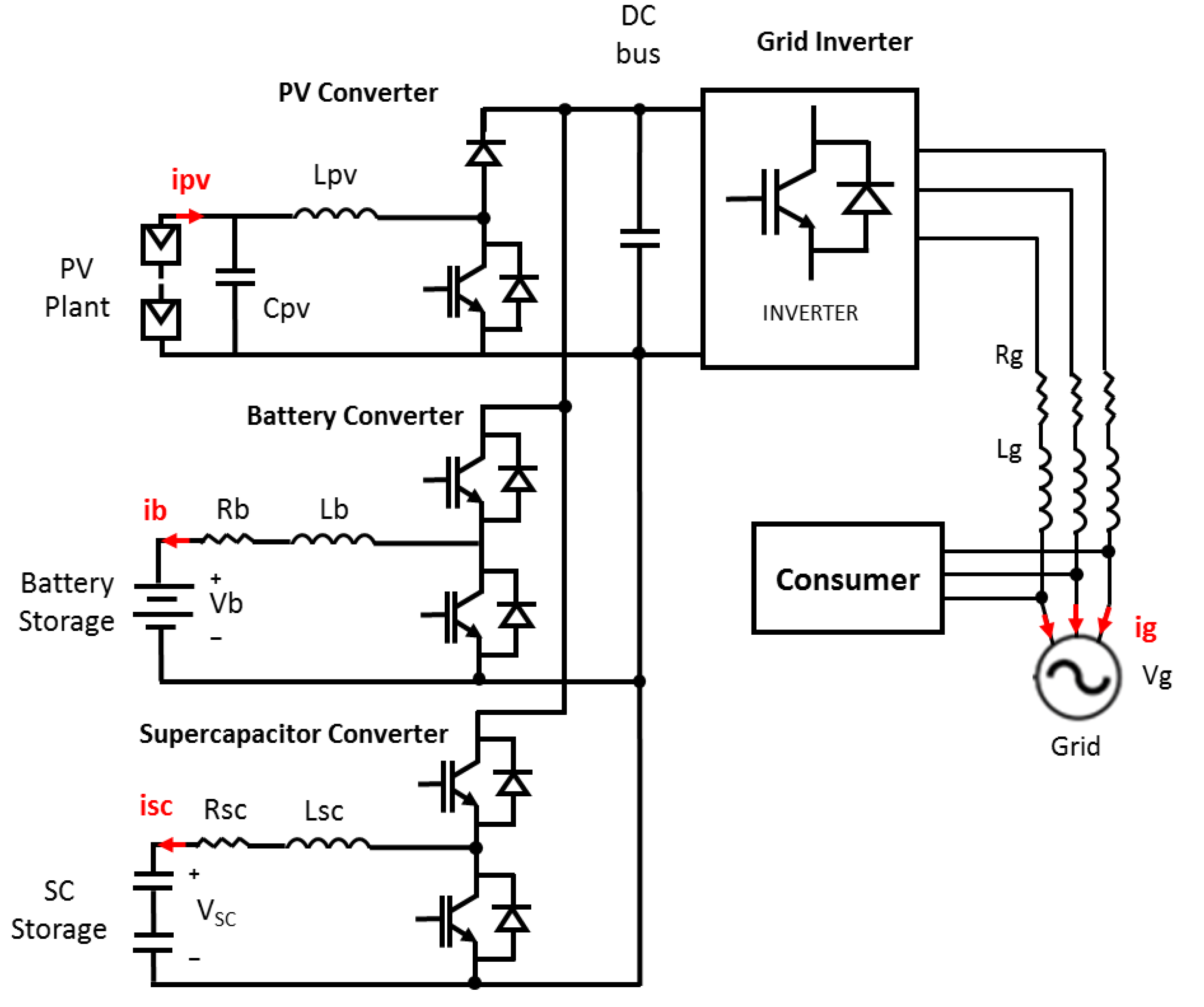
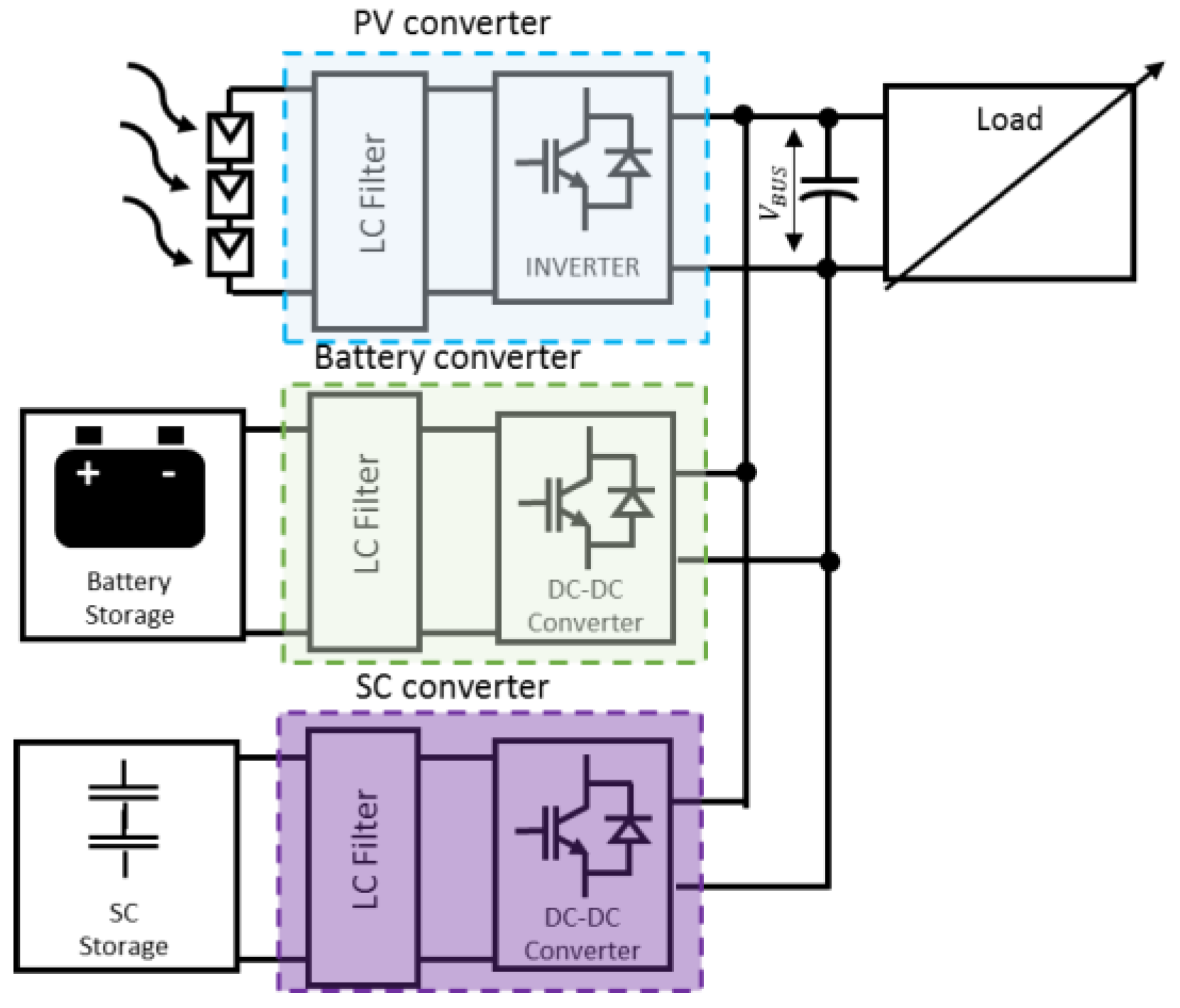
| Nature | Electrical Energy Storage Technology |
|---|---|
| Electromechanical |
|
| Electromagnetic | Superconducting Magnetic Energy Storage (SMES) |
| Electrochemical | Batteries (BESS) |
| Chemical | Fuel Cells (FCs) |
| Electrostatic | Supercapacitors (SCs) |
| Cycle Duration (time) | Electrical Energy Storage Technology |
|---|---|
| Very short (<10 s) | Capacitors, inductors |
| Short (1 s to 15 min) | SCs, FESS, SMES |
| Medium (5 min to 24 h) | Batteries |
| Long (days) | Batteries, CAES, HPES |
| ESS Technology | Advantages | Drawbacks |
|---|---|---|
| Batteries | Low self discharge Narrow range of voltage variation in operation High energy density Low installation cost | Accelerated aging with large power pulses Low recyclability of materials Reduced operating temperature range Low power density Need for a BMS |
| Supercapacitors | High power density Wide operating temperature range Ageing not dependent on the duty cycle More stable efficiency throughout the operating range | Wide voltage variation in operation Power converter required to operate Voltage balancing system between cells required Low energy densisty Higher cost (€/kWh) |
| Flywheels | High energy density Power and Energy decoupling Less ageing than batteries and supercapacitors Very wide operating temperature range | High self-discharge High installation cost Lower efficiency than batteries and SCs Power converter required |
Publisher’s Note: MDPI stays neutral with regard to jurisdictional claims in published maps and institutional affiliations. |
© 2021 by the authors. Licensee MDPI, Basel, Switzerland. This article is an open access article distributed under the terms and conditions of the Creative Commons Attribution (CC BY) license (https://creativecommons.org/licenses/by/4.0/).
Share and Cite
Navarro, G.; Torres, J.; Blanco, M.; Nájera, J.; Santos-Herran, M.; Lafoz, M. Present and Future of Supercapacitor Technology Applied to Powertrains, Renewable Generation and Grid Connection Applications. Energies 2021, 14, 3060. https://doi.org/10.3390/en14113060
Navarro G, Torres J, Blanco M, Nájera J, Santos-Herran M, Lafoz M. Present and Future of Supercapacitor Technology Applied to Powertrains, Renewable Generation and Grid Connection Applications. Energies. 2021; 14(11):3060. https://doi.org/10.3390/en14113060
Chicago/Turabian StyleNavarro, Gustavo, Jorge Torres, Marcos Blanco, Jorge Nájera, Miguel Santos-Herran, and Marcos Lafoz. 2021. "Present and Future of Supercapacitor Technology Applied to Powertrains, Renewable Generation and Grid Connection Applications" Energies 14, no. 11: 3060. https://doi.org/10.3390/en14113060
APA StyleNavarro, G., Torres, J., Blanco, M., Nájera, J., Santos-Herran, M., & Lafoz, M. (2021). Present and Future of Supercapacitor Technology Applied to Powertrains, Renewable Generation and Grid Connection Applications. Energies, 14(11), 3060. https://doi.org/10.3390/en14113060









